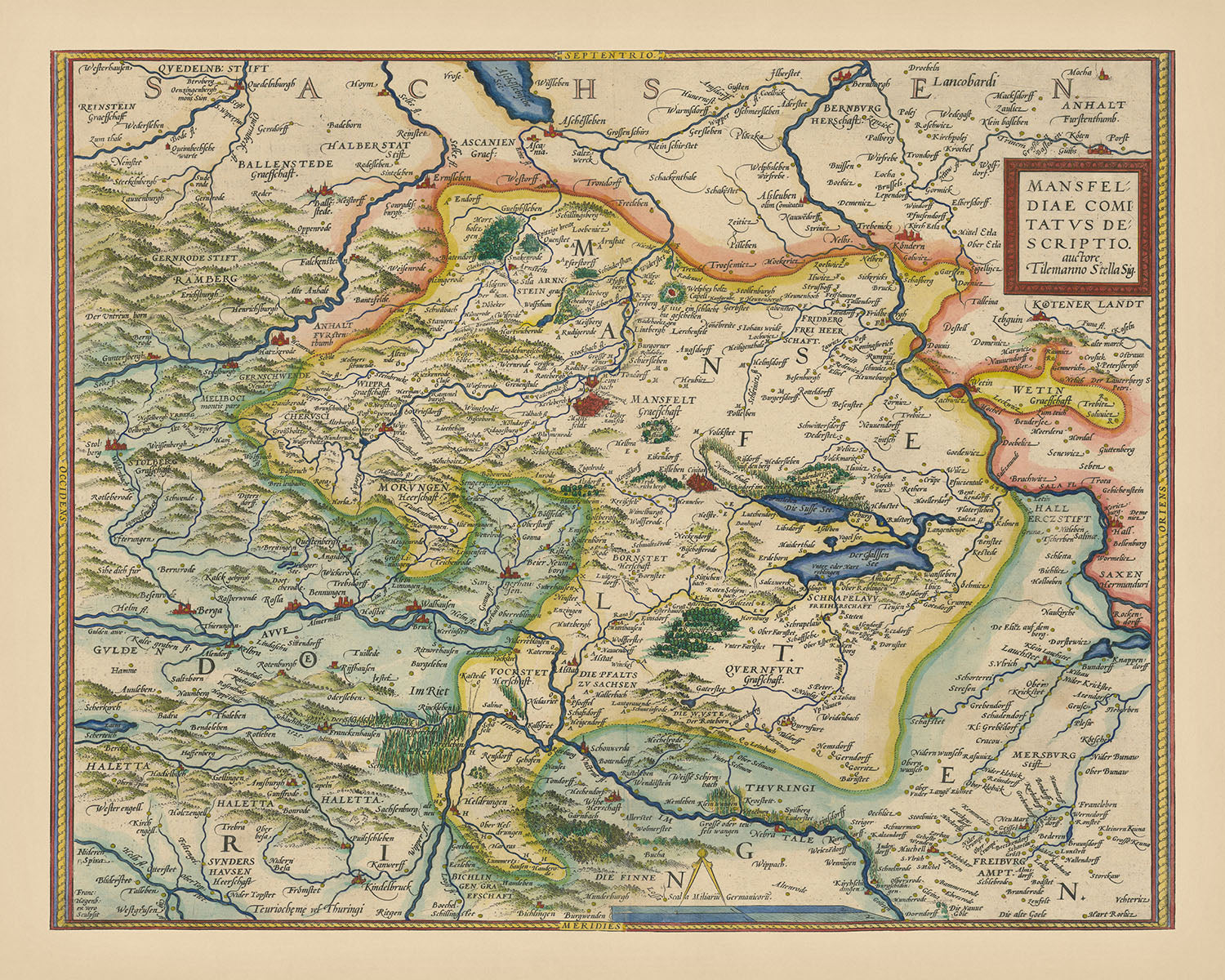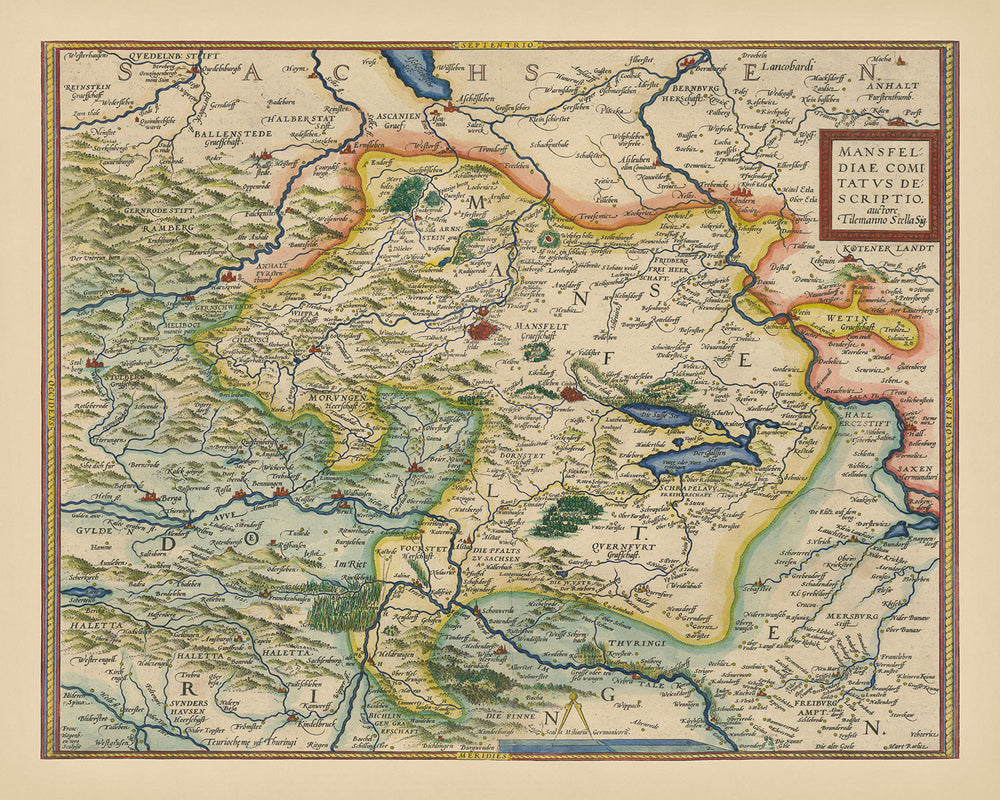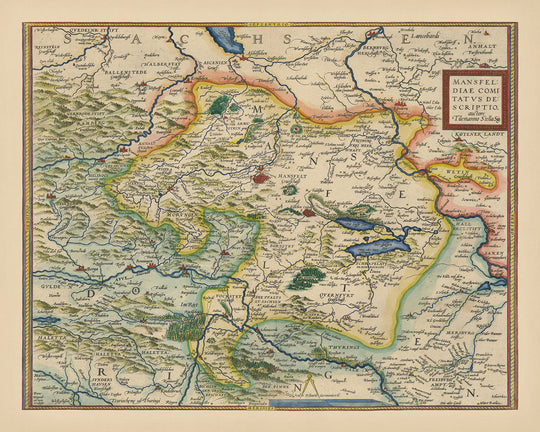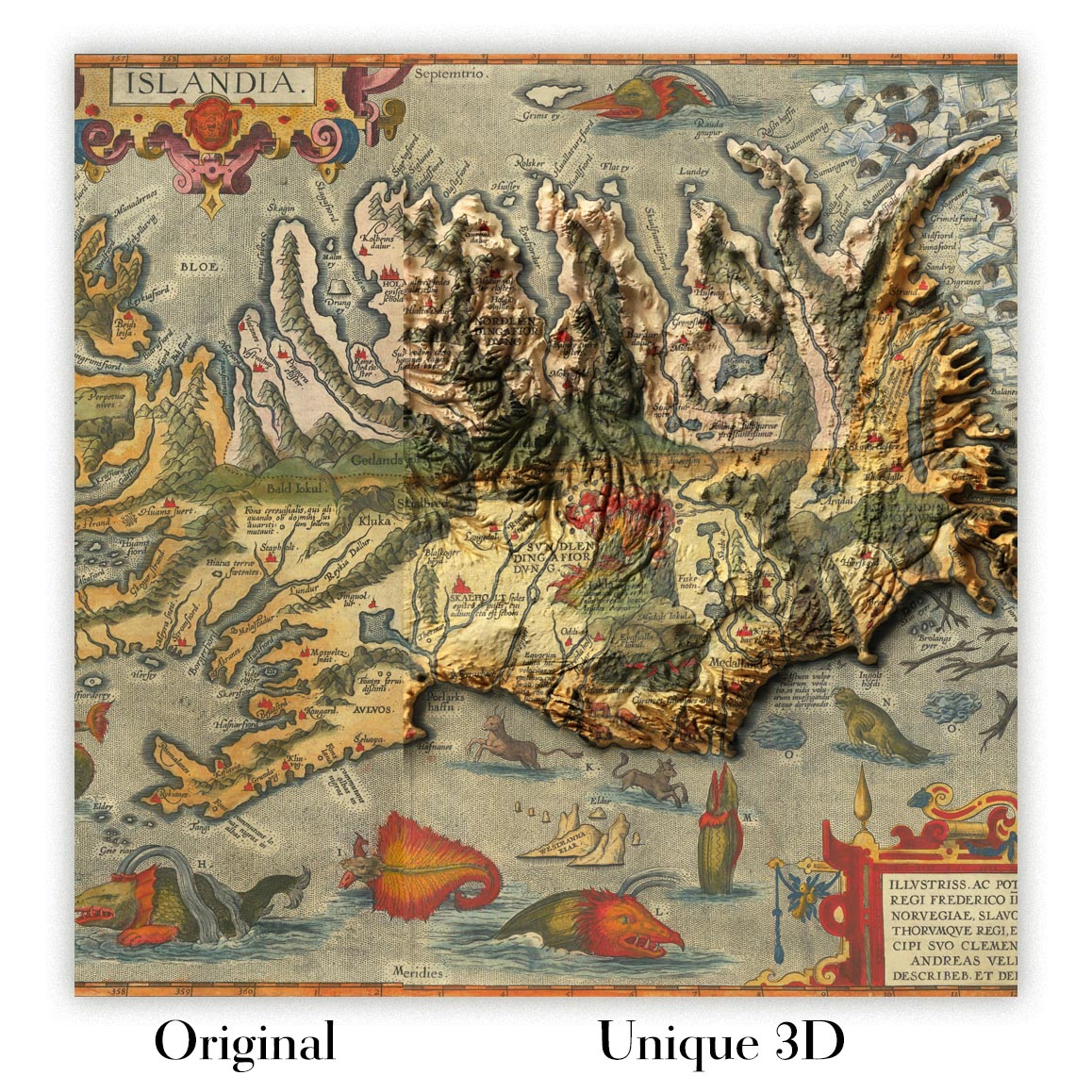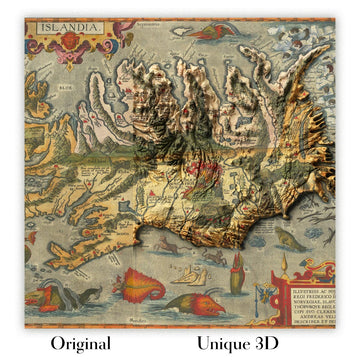- Handmade locally. No import duty or tax
- FREE Delivery. Arrives in 2-3 days
- Love it or your money back
- Questions? WhatsApp me any time
Own a piece of history
5,000+ 5 star reviews


Mansfeldiae Comitatus Descriptio auctore Tilemanno Stella Sig., crafted by the illustrious cartographer Abraham Ortelius in 1575, is a masterpiece of Renaissance cartography. This map is a stunning example of Ortelius' work, showcasing the ancient district of Mansfeld, now part of Mansfeld-Südharz, and its surrounding regions in Germany. Ortelius, renowned for creating the first modern atlas, Theatrum Orbis Terrarum, has meticulously detailed the political and physical landscapes of the area, making this map not only a valuable historical document but also a piece of art.
The map is rich in geographical features, depicting the Salsa River flowing from Bernburgh to Rockendorf and the Helm River from Berga to Dorndorff. The intricate old color technique used by Ortelius brings to life the varied terrain, including dense forests, rolling hills, and possibly mountainous regions. The detailed illustrations of these physical features provide a vivid snapshot of the natural world as it was understood in the 16th century, offering a fascinating glimpse into the past.
Ortelius' map is not just a geographical document; it is a political one as well. The detailed depiction of the district of Mansfeld and its neighboring regions reflects the complex political boundaries of the time. The map highlights the importance of Mansfeld and its strategic location within Germany, surrounded by significant towns and cities such as Halle, Ascanien, and Halberstat. These settlements, meticulously marked and named, offer insights into the political landscape and urban development of the era.
The artistic elements of the map are equally captivating. The ornate cartouches and embellishments, characteristic of Ortelius' style, add a decorative flair that elevates the map from a mere navigational tool to a work of art. These decorative elements, combined with the old color technique, create a visually stunning piece that is as aesthetically pleasing as it is informative. The map's design reflects the Renaissance ideals of beauty and knowledge, embodying the era's spirit of exploration and discovery.
Historically, this map holds significant value as part of Ortelius' Theatrum Orbis Terrarum, the first modern atlas. It provides a unique window into the 16th-century world, capturing the geographical knowledge and political realities of the time. The map's detailed depiction of rivers, forests, and towns, along with its artistic flourishes, makes it a prized possession for collectors and historians alike. Owning this map is like holding a piece of history, a testament to the enduring legacy of Abraham Ortelius and his contributions to the field of cartography.
Cities and towns on this map
- County of Mansfeld:
- Mansfeld
- Bernburgh
- Rockendorf
- Dorndorff
- Berga
- Halle
- Ascanien
- Halberstat
- Helbron
- Thale
- Freyberg
- Merynberg
- Sondershausen
- Tarnow
- Ballenstede
- Anhalt
- Sangerhausen
- Artern
- Eisleben
- Querfurt
- Weissenfels
- Zeitz
- Naumburg
- Apolda
- Weimar
- Jena
- Erfurt
- Gotha
- Eisenach
- Mühlhausen
Notable Features & Landmarks
- Rivers:
- Salsa River
- Helm River
- Forests:
- Several dense forested areas depicted, though not individually named.
- Terrain:
- Varied terrain including hills and possibly mountainous regions.
- Political Boundaries:
- Detailed depiction of the County of Mansfeld and surrounding regions.
- Decorative Elements:
- Ornate cartouches and embellishments typical of Ortelius' maps.
- Bodies of Water:
- Various smaller lakes and ponds.
- Roads and Paths:
- Some pathways or roads connecting major settlements.
Historical and design context
- Name of the map: Mansfeldiae Comitatus Descriptio auctore Tilemanno Stella Sig.
- When the map was made: 1575
- Mapmaker or publisher: Abraham Ortelius
- Interesting context about the mapmaker: Ortelius is known for creating the first modern atlas, Theatrum Orbis Terrarum.
- Topics and themes shown on the map:
- Political boundaries: Detailed depiction of the County of Mansfeld and surrounding regions.
- Physical features: Rivers such as the Salsa and Helm, and various terrains including forests and hills.
- Countries and regions shown on the map:
- Germany, specifically the County of Mansfeld and adjacent areas.
- Design or style of the map:
- Old color technique, characteristic of 16th-century cartography.
- Detailed illustrations of physical and political features.
- Historical significance or context:
- Part of the first modern atlas, providing valuable historical insights into the geography and political boundaries of 16th-century Germany.
Please double check the images to make sure that a specific town or place is shown on this map. You can also get in touch and ask us to check the map for you.
This map looks great at every size, but I always recommend going for a larger size if you have space. That way you can easily make out all of the details.
This map looks amazing at sizes all the way up to 70in (180cm). If you are looking for a larger map, please get in touch.
The model in the listing images is holding the 16x20in (40x50cm) version of this map.
The fifth listing image shows an example of my map personalisation service.
If you’re looking for something slightly different, check out my collection of the best old maps to see if something else catches your eye.
Please contact me to check if a certain location, landmark or feature is shown on this map.
This would make a wonderful birthday, Christmas, Father's Day, work leaving, anniversary or housewarming gift for someone from the areas covered by this map.
This map is available as a giclée print on acid free archival matte paper, or you can buy it framed. The frame is a nice, simple black frame that suits most aesthetics. Please get in touch if you'd like a different frame colour or material. My frames are glazed with super-clear museum-grade acrylic (perspex/acrylite), which is significantly less reflective than glass, safer, and will always arrive in perfect condition.
This map is also available as a float framed canvas, sometimes known as a shadow gap framed canvas or canvas floater. The map is printed on artist's cotton canvas and then stretched over a handmade box frame. We then "float" the canvas inside a wooden frame, which is available in a range of colours (black, dark brown, oak, antique gold and white). This is a wonderful way to present a map without glazing in front. See some examples of float framed canvas maps and explore the differences between my different finishes.
For something truly unique, this map is also available in "Unique 3D", our trademarked process that dramatically transforms the map so that it has a wonderful sense of depth. We combine the original map with detailed topography and elevation data, so that mountains and the terrain really "pop". For more info and examples of 3D maps, check my Unique 3D page.
For most orders, delivery time is about 3 working days. Personalised and customised products take longer, as I have to do the personalisation and send it to you for approval, which usually takes 1 or 2 days.
Please note that very large framed orders usually take longer to make and deliver.
If you need your order to arrive by a certain date, please contact me before you order so that we can find the best way of making sure you get your order in time.
I print and frame maps and artwork in 23 countries around the world. This means your order will be made locally, which cuts down on delivery time and ensures that it won't be damaged during delivery. You'll never pay customs or import duty, and we'll put less CO2 into the air.
All of my maps and art prints are well packaged and sent in a rugged tube if unframed, or surrounded by foam if framed.
I try to send out all orders within 1 or 2 days of receiving your order, though some products (like face masks, mugs and tote bags) can take longer to make.
If you select Express Delivery at checkout your order we will prioritise your order and send it out by 1-day courier (Fedex, DHL, UPS, Parcelforce).
Next Day delivery is also available in some countries (US, UK, Singapore, UAE) but please try to order early in the day so that we can get it sent out on time.
My standard frame is a gallery style black ash hardwood frame. It is simple and quite modern looking. My standard frame is around 20mm (0.8in) wide.
I use super-clear acrylic (perspex/acrylite) for the frame glass. It's lighter and safer than glass - and it looks better, as the reflectivity is lower.
Six standard frame colours are available for free (black, dark brown, dark grey, oak, white and antique gold). Custom framing and mounting/matting is available if you're looking for something else.
Most maps, art and illustrations are also available as a framed canvas. We use matte (not shiny) cotton canvas, stretch it over a sustainably sourced box wood frame, and then 'float' the piece within a wood frame. The end result is quite beautiful, and there's no glazing to get in the way.
All frames are provided "ready to hang", with either a string or brackets on the back. Very large frames will have heavy duty hanging plates and/or a mounting baton. If you have any questions, please get in touch.
See some examples of my framed maps and framed canvas maps.
Alternatively, I can also supply old maps and artwork on canvas, foam board, cotton rag and other materials.
If you want to frame your map or artwork yourself, please read my size guide first.
My maps are extremely high quality reproductions of original maps.
I source original, rare maps from libraries, auction houses and private collections around the world, restore them at my London workshop, and then use specialist giclée inks and printers to create beautiful maps that look even better than the original.
My maps are printed on acid-free archival matte (not glossy) paper that feels very high quality and almost like card. In technical terms the paper weight/thickness is 10mil/200gsm. It's perfect for framing.
I print with Epson ultrachrome giclée UV fade resistant pigment inks - some of the best inks you can find.
I can also make maps on canvas, cotton rag and other exotic materials.
Learn more about The Unique Maps Co.
Map personalisation
If you're looking for the perfect anniversary or housewarming gift, I can personalise your map to make it truly unique. For example, I can add a short message, or highlight an important location, or add your family's coat of arms.
The options are almost infinite. Please see my map personalisation page for some wonderful examples of what's possible.
To order a personalised map, select "personalise your map" before adding it to your basket.
Get in touch if you're looking for more complex customisations and personalisations.
Map ageing
I have been asked hundreds of times over the years by customers if they could buy a map that looks even older.
Well, now you can, by selecting Aged before you add a map to your basket.
All the product photos you see on this page show the map in its Original form. This is what the map looks like today.
If you select Aged, I will age your map by hand, using a special and unique process developed through years of studying old maps, talking to researchers to understand the chemistry of aging paper, and of course... lots of practice!
If you're unsure, stick to the Original colour of the map. If you want something a bit darker and older looking, go for Aged.
If you are not happy with your order for any reason, contact me and I'll get it fixed ASAP, free of charge. Please see my returns and refund policy for more information.
I am very confident you will like your restored map or art print. I have been doing this since 1984. I'm a 5-star Etsy seller. I have sold tens of thousands of maps and art prints and have over 5,000 real 5-star reviews. My work has been featured in interior design magazines, on the BBC, and on the walls of dozens of 5-star hotels.
I use a unique process to restore maps and artwork that is massively time consuming and labour intensive. Hunting down the original maps and illustrations can take months. I use state of the art and eye-wateringly expensive technology to scan and restore them. As a result, I guarantee my maps and art prints are a cut above the rest. I stand by my products and will always make sure you're 100% happy with what you receive.
Almost all of my maps and art prints look amazing at large sizes (200cm, 6.5ft+) and I can frame and deliver them to you as well, via special oversized courier. Contact me to discuss your specific needs.
Or try searching for something!







